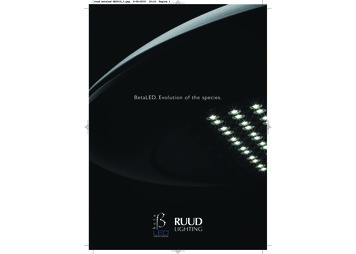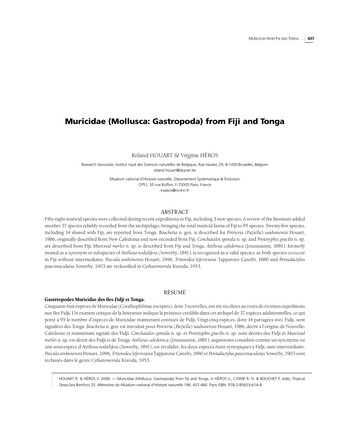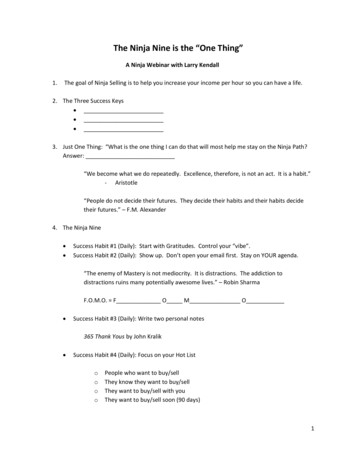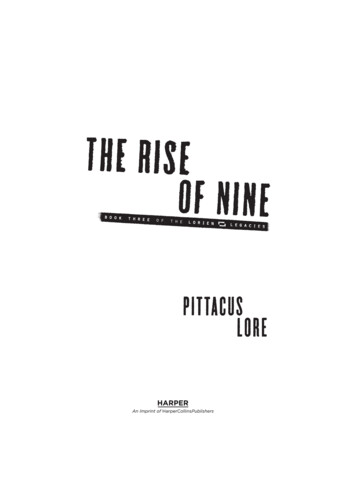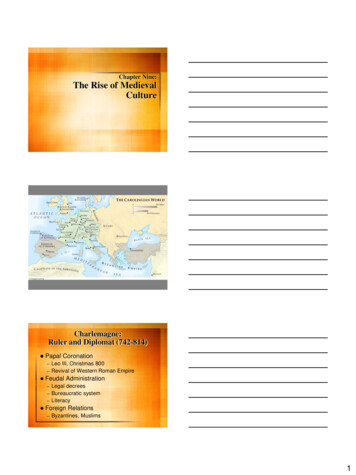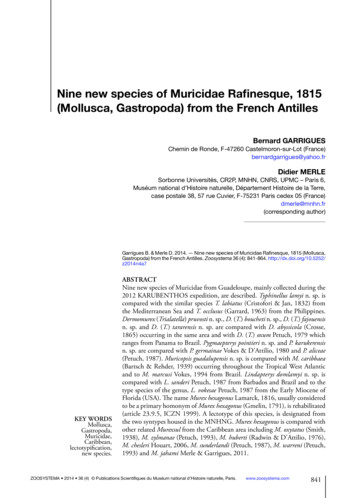
Transcription
Nine new species of Muricidae Rafinesque, 1815(Mollusca, Gastropoda) from the French AntillesBernard GARRIGUESChemin de Ronde, F-47260 Castelmoron-sur-Lot (France)bernardgarrigues@yahoo.frDidier MERLESorbonne Universités, CR2P, MNHN, CNRS, UPMC – Paris 6,Muséum national d’Histoire naturelle, Département Histoire de la Terre,case postale 38, 57 rue Cuvier, F-75231 Paris cedex 05 (France)dmerle@mnhn.fr(corresponding author)Garrigues B. & Merle D. 2014. — Nine new species of Muricidae Rafinesque, 1815 (Mollusca,Gastropoda) from the French Antilles. Zoosystema 36 (4): 841-864. http://dx.doi.org/10.5252/z2014n4a7KEY typification,new species.ABSTRACTNine new species of Muricidae from Guadeloupe, mainly collected during the2012 KARUBENTHOS expedition, are described. Typhinellus lamyi n. sp. iscompared with the similar species T. labiatus (Cristofori & Jan, 1832) fromthe Mediterranean Sea and T. occlusus (Garrard, 1963) from the Philippines.Dermomurex (Trialatella) pruvosti n. sp., D. (T.) boucheti n. sp., D. (T.) fajouensisn. sp. and D. (T.) tararensis n. sp. are compared with D. abyssicola (Crosse,1865) occurring in the same area and with D. (T.) oxum Petuch, 1979 whichranges from Panama to Brazil. Pygmaepterys pointieri n. sp. and P. karukerensisn. sp. are compared with P. germainae Vokes & D’Attilio, 1980 and P. aliceae(Petuch, 1987). Muricopsis guadalupensis n. sp. is compared with M. caribbaea(Bartsch & Rehder, 1939) occurring throughout the Tropical West Atlanticand to M. marcusi Vokes, 1994 from Brazil. Lindapterys domlamyi n. sp. iscompared with L. sanderi Petuch, 1987 from Barbados and Brazil and to thetype species of the genus, L. vokesae Petuch, 1987 from the Early Miocene ofFlorida (USA). The name Murex hexagonus Lamarck, 1816, usually consideredto be a primary homonym of Murex hexagonus (Gmelin, 1791), is rehabilitated(article 23.9.5, ICZN 1999). A lectotype of this species, is designated fromthe two syntypes housed in the MNHNG. Murex hexagonus is compared withother related Murexsul from the Caribbean area including M. oxytatus (Smith,1938), M. zylmanae (Petuch, 1993), M. huberti (Radwin & D’Attilio, 1976),M. chesleri Houart, 2006, M. sunderlandi (Petuch, 1987), M. warreni (Petuch,1993) and M. jahami Merle & Garrigues, 2011.ZOOSYSTEMA 2014 36 (4) Publications Scientifiques du Muséum national d’Histoire naturelle, Paris.www.zoosystema.com841
Garrigues B. & Merle D.MOTS typification,espèces nouvelles.RÉSUMÉNeuf espèces nouvelles de Muricidae Rafinesque, 1815 (Mollusca, Gastropoda) desAntilles Françaises.Neuf espèces nouvelles de Muricidae de Guadeloupe, principalement récoltéeslors de l’expédition KARUBENTHOS en 2012, sont décrites. Typhinellus lamyin. sp. est comparé à des espèces similaires :T. labiatus (Cristofori & Jan, 1832)de Méditerranée et T. occlusus (Garrard, 1963) des Philippines. Dermomurex(Trialatella) pruvosti n. sp., D. (T.) boucheti n. sp., D. (T.) fajouensis n. sp. etD. (T.) tararensis n. sp. sont comparés à D. abyssicola (Crosse, 1865) qui estprésent dans la même région et à D. (T.) oxum Petuch, 1979 connu du Panamaau Brésil. Pygmaepterys pointieri n. sp. et P. karukerensis n. sp. sont comparés àP. germainae Vokes & D’Attilio, 1980 et à P. aliceae (Petuch, 1987). Muricopsisguadalupensis n. sp. est comparé à M. caribbaea (Bartsch & Rehder, 1939) présentdans l’ensemble de l’ouest Atlantique tropical et à M. marcusi Vokes, 1994 duBrésil. Lindapterys domlamyi n. sp. est comparé à L. sanderi Petuch, 1987, connude la Barbade au Brésil et à l’espèce type du genre, L. vokesae Petuch, 1987 connudans le Miocène inférieur de Floride (USA). Murex hexagonus Lamarck, 1816,nom généralement considéré comme homonyme primaire de Murex hexagonusGmelin, 1791 est réhabilité (article 23.9.5, CIZN 1999). Un lectotype de cetteespèce est désigné à partir des deux syntypes conservés au MHNG. Murexsulhexagonus est comparé à d’autres espèces proches de Murexsul des Caraïbes :M. oxytatus (Smith, 1938), M. zylmanae (Petuch, 1993), M. huberti (Radwin &D’Attilio, 1976), M. chesleri Houart, 2006, M. sunderlandi (Petuch, 1987),M. warreni (Petuch, 1993) et M. jahami Merle & Garrigues, 2011.IntroductionThe Lesser Antilles is an area of the Caribbean displaying a very rich muricid fauna, with 84 presentlyknown species (Lamy & Pointier, in press). Sincethe year 2000, five new species have been describedfrom this region (Merle et al. 2001; Houart 2006;Merle & Garrigues 2011). Recent marine malacological research carried out in Guadeloupe (Fig. 1)has led to the discovery of ten additional muricidspecies described here as new and belonging to thegenera Typhinellus Jousseaume, 1880, DermomurexMonterosato, 1890, Pygmaepterys Vokes, 1978,Muricopsis Bucquoy & Dautzenberg, 1882, MurexsulIredale, 1915 and Lindapterys Petuch, 1987. Themajority of these species were discovered in May2012, during the KARUBENTHOS expedition(Principal Investigator: Philippe Bouchet), organized jointly by the National Park of Guadeloupe,MNHN, UAG, and UPMC. This paper follows842other papers updating the biodiversity of this areathanks to the KARUBENTHOS expedition (Orteaet al. 2012; Espinosa & Ortea 2013; Pelorce &Faber 2013).Material and methodsAbbreviationsThe descriptive methodology used here followsthat of Merle (1999, 2001, 2005) and Merle et al.(2011) and the text conventions used to describethe spiral sculpture and the internal denticles ofthe outer lip are given below.MorphologyABPabisabsADPabapical siphonal primary cord;abapical infrasutural secondary cord;abapical siphonal secondary cord;adapical siphonal primary cord;ZOOSYSTEMA 2014 36 (4)
Nine new muricid species from the French AntillesABIDGN01 GD35 1FGS39FortuneAtlantic OceanGD60CPetiteTerreMarieGalanteSaintes10 kmFig. 1. — Geographical map of the Guadeloupe with the stations KARUNBENTHOS (GB, GD, GM and GS, see also the website of theMNHN 12) for more details concerning the stations), the other stations (eF: East ofFajou in 80-90 m deep and Ma: Malendure at 10 m) and the localization of the new species. A, Typhinellus lamyi n. sp.; B, Dermomurex(Trialatella) pruvosti n. sp.; C, D. (T.) boucheti n. sp.; D, D. (T.) fajouensis n. sp. ; E, D. (T.) tararensis n. sp.; F, Pygmaepterys pointierin. sp.; G, P. karukerensis n. sp.; H, Muricopsis guadalupensis n. sp. ; I, Lindapterys domlamyi n. sp.adisadapical infrasutural secondary cord;adsadapical siphonal secondary cord;EAB1extreme abapical siphonal primary cord;D1-D6abapical apertural denticles;IDinfrasutural apertural denticle;IPinfrasutural primary cord;MPmedian siphonal primary cord;msmedian siphonal secondary cord;Pprimary cord (cord appearing in first order);P1shoulder cord;P2-P6 primary cords of the convex part of the teleoconch whorl;s secondary cord (cord appearing in second order);s1-s6 secondary cords of the convex part of theteleoconch whorl;ZOOSYSTEMA 2014 36 (4)tDHtertiary cord (cord appearing in third order).diameter;height.RepositoryANSP Academy of Natural Sciences of Philadelphia,Pennsylvania;CMNH Carnegie Museum of Natural History, Pittsburg, Pennsylvania;MNHN Muséum national d’Histoire naturelle (sector: Recent molluscs), Paris;MHNG Muséum d’Histoire naturelle, Geneva;SDNHM San Diego Natural History Museum, California;843
Garrigues B. & Merle D.UAG Université des Antilles et de la Guyane,Pointe-à-Pitre;UFUniversity of Tampa, Florida;UPMCUniversité Pierre et Marie Curie, Paris;USNM National Museum of Natural History, Smithsonian Institution, Washington DC;coll. BG Bernard Garrigues collection (Castelmoron,France);coll. DL Dominique Lamy collection (Baie Mahault,Guadeloupe);coll. JP Jacques Pellorce collection (Le Grau du Roi,France).SYSTEMATICSFamily Muricidae Rafinesque, 1815Subfamily Typhinae Cossmann, 1903Genus Typhinellus Jousseaume, 1880Type species. — Typhis sowerbii Broderip, 1833 (byoriginal designation), junior synonym of Murex labiatusCristofori & Jan, 1832. Middle Miocene: Eastern Atlantic;Pliocene to Pleistocene: eastern and western Atlantic;Recent: eastern and western Atlantic, Somalia and OmanGulf (Landau et al. 2007).Typhinellus lamyi n. sp.(Figs 2A-F; 11A)Type material. — Holotype (MNHN-IM-2013-7776),DNA sequenced (GenBank no. KJ591665), KARUBENTHOS: stn GD35, Port Louis, 16 22.77’N, 61 34.19’W,at 66 m deep; one paratype (MNHN-IM-2013-20576),DNA sequenced (not tissue-clipped), KARUBENTHOS:stn GD55, Fajou Island, 16 22.48’N, 61 35.46’W, at85 m deep; one paratype (coll. DL), East of Fajou Island,in 80-90 m deep; one paratype (coll. BG), East of FajouIsland, in 80-90 m deep.Type locality. — Guadeloupe, Port Louis, 16 22.77’N,61 34.19’W (stn GD35) at 66 m deep.Etymology. — Named in honour of Dominique Lamy.Description of the holotypeProtoconch of 1.75 whorls. Teleoconch, H 13.1 mm,D 5.9 mm. Low spire of fours whorls. Last whorl of81% of the total length. Shoulder angulation sharp.844Apical angle of 85 . Suture impressed crossed by alaminar extension connecting the shoulder spine tothe preceding teleoconch whorl. Spiral sculpture:IP on the sutural ramp, P1 corresponding to analtube, P2, P3, P4 and P5 on convex part of thewhorl, P6, ADP, MP on siphonal canal. Primarycords slightly marked near the varices. P1 and P2appearing since the first whorl. Primary cord spineson IP, P2, P3, P4 and P5. On the last whorl, broadvarical flange up to the extremity of siphonal canal.Four ventrally sealed anal tubes (P1 spine), abapicallyand dorsally recurved, forming an angle of 30 withthe axis of the shell. Last tube intact, others cutdown. Axial sculpture: four varices since the firstwhorl. Aperture rounded. Columellar lip smooth,erected. No anal sulcus. Outer lip erected and smoothwithin. Siphonal canal winding, ventrally sealed,dorsally curved, up to 40.4 % of the total length.Microsculpture of growing grooves. Shell chocolate,beige and white. Anal tubes (P1), siphonal canaland aperture whitish. Several dark blotches on theventral part of the siphonal canal (3 blotches) andthe outer lip (4 blotches). Operculum and radulaunknown.ComparisonBecause of its moderately high shape and itsdeveloped cords spines, Typhinellus lamyi n. sp.should be compared with T. occlusus (Garrard,1963) recorded from the Philippines and NewCaledonia (80-200 m deep) and with T. labiatus(Cristofori & Jan, 1832). Specimens of T. occlususcan resemble T. lamyi n. sp. in bearing three darkblotches on the siphonal canal (Fig. 2I and Hardy2014); however, T. occlusus (Fig. 2I) differs mainly bya smaller aperture, a longer siphonal canal (45.6 %of the total length) and a larger size up to 25-35 mm(instead 9.5-13 mm). On the biogeographical pointof view, T. labiatus is closer to T. lamyi n. sp., bothspecies living in the Atlantic Ocean. The shapeof T. labiatus is rather similar to that of T. lamyin. sp. and as for T. occlusus, several specimens ofT. labiatus can resemble T. lamyi n. sp. in bearingthree dark blotches on the siphonal canal (Hardy2014). T. labiatus (Fig. 2G, H) differs by its spiralsculpture; it displays secondary cords spines s2 ands4 missing in T. lamyi n. sp. (Fig. 11A).ZOOSYSTEMA 2014 36 (4)
Nine new muricid species from the French AntillesACBEFDA-FGHIIG-HFig. 2. — A-F, Typhinellus lamyi n. sp.: A-C, ventral, profil and dorsal views holotype MNHN-IM-2013-7776, Port Louis (stn GD35) at66 m deep; D, E, ventral and dorsal views paratype, coll. DL, East of Fajou Island, in 80-90 m deep; F, dorsal view paratype MNHNIM-2013-20576, Fajou Island, at 85 m deep; G, H, ventral and dorsal views T. labiatus (Cristofori & Jan, 1832), coll. BG, Kerkennah (Tunisia),at 1 m deep; I, (ventral view) T. occlusus (Garrard, 1963), coll. BG, Balut Island (Philippines), in 80-150 m deep. Scale bars: 10 mm.ZOOSYSTEMA 2014 36 (4)845
Garrigues B. & Merle D.Subfamily Muricinae Rafinesque, 1815Incertae sedisGenus Dermomurex Monterosato, 1890Type species. — Murex scalarinus Bivona-Bernardi,1832 (by original designation) junior synonym of Murexscalaroides Blainville, 1829. Pliocene: MediterraneanSea; Recent, Mediterranean Sea and Senegal (see Merleet al. 2011).RemarksIn their muricid phylogeny based on moleculardata, Barco et al. (2010) strongly suggested thepolyphyly of the Muricinae sensu Vokes (1996),but, as the relationships with the clade Muricinae(s.s.) are not resolved, we cannot be totally sure ofthe lack of relationships between the Dermomurexsubclade and the Attiliosa-Muricopsinae subcladeand the clade Muricinae (s.s.). Considering theseresults, Merle et al. (2011) assigned Dermomurex toan informal Aspelloid group, for which the statusamong the clade of the Muricinae (s.s.) remainsuncertain or needs to be verified.Subgenus Trialatella Berry, 1964Type species. — Trialatella cunninghamae Berry, 1964by original designation. Recent: west coast of CentralAmerica from Gulf of California, Mexico to Panama.Dermomurex (Trialatella) pruvosti n. sp.(Figs 3A-D; 4B; 11C)Type material. — Holotype (MNHN IM-2000-27726);one paratype (MNHN IM-2000-27727) KARUBENTHOS 2012: stn GN01, 16 22.4’N, 61 35.6’W, at80 m deep, Fajou Island; one paratype (coll. DL), Eastof Fajou Island, in 80-90 m deep.Type locality. — Guadeloupe, Fajou Island, 16 22.4’N,61 35.6’W (stn GN01), at 80 m deep.Etymology. — Named in honour of Laurent Pruvost.Description of the holotypeProtoconch of 1.25 whorls. Teleoconch biconic,H 10.2 mm, D 5.7 mm. High spire of five whorls.846Last whorl rounded, 73 % of the total length ofteleoconch. Apical angle of 55 . Spiral sculptureconsisting in marked primary cords. Appearance of P1and P2 since the third whorl. IP on the sutural ramp.Convex part of the whorl: P1, P2, P4 well developed,P5 smaller, P3 atrophied. Siphonal canal: P6, ADPand MP. On four first whorls: six protovarices. Onfourth whorl: gradual appearance of three varicesand three intervarical ribs (intercalated betweentwo varices). On last whorl: four varices and threeintervarical ribs (intercalated between two varices).Aperture ovate. Columellar lip smooth and slightlyerected anteriorly. Outer lip crenulated and flared.Internal denticles D1, D2, D3, D4 and D5 simple.Siphonal canal open, dorsally recurved and up to23 % of total length of teleoconch. Microsculpture:thin spiral threads on the whole surface of the shell.Intritacalx cancellate. Shell brown under a creamyintritacalx. Aperture brown with darker denticles.Operculum and radula unknown.Comparison (see also Table 1)In comparison with Dermomurex (Trialatella) abyssicola (Crosse, 1865) (Fig. 3I, J), a species rangingfrom Bahamas to Brazil between 0.5 m and 20 mdeep, D. (T.) pruvosti n. sp. differs by a nodulosesculpture formed by small protuberances at theintersection between the varices and the primarycords. Dermomurex (T.) pruvosti n. sp. is also distinguishing from D. (T.) abyssicola by developedwing-like varices and by an atrophied P3 on theconvex part of the whorl. D. (T.) pruvosti n. sp. isbrown, instead yellow-whitish in D. (T.) abyssicola.Dermomurex (Trialatella) boucheti n. sp.(Figs 3N-P; 4C; 11D)Type material. — Holotype (MNHN-IM-2013-8857),DNA sequenced (GenBank no. KJ591660), KARU BENTHOS 2012, stn GD60, 16 12.05’N – 61 03.9’W,at 95 m deep.Type locality. — East of Petite Terre Island, Guadeloupe,16 12.05’N – 61 03.9’W (GD60), at 95 m deep.Etymology. — Named in honour of Philippe Bouchet.ZOOSYSTEMA 2014 36 (4)
Nine new muricid species from the French AntillesABCDEFGA-LHIJKLPMNM-POFig. 3. — A-D, Dermomurex (Trialatella) pruvosti n. sp.: A-C, ventral, profil and dorsal views, holotype MNHN IM-2000-27726, FajouIsland, at 80 m deep; D, ventral view, paratype, coll. DL, East of Fajou Island, in 80-90 m deep; E-H, D. (T.) fajouensis n. sp.; E, F, ventraland dorsal views, holotype MNHN IM-2000-27733, East of Fajou Island, at 80 m deep; G, H, ventral and dorsal views, paratype MNHNIM-2000-27734, East of Fajou Island, at 80 m deep; I, J, ventral and dorsal views, D. (T.) abyssicola (Crosse, 1865), coll. DL, SouthRocroy, Guadeloupe, at 7 m deep; K, L, ventral and dorsal views, D. (T.) tararensis n. sp., holotype MNHN IM-2000-27728, Anse Tarare,at 60 m deep; M, ventral view, D. (T.) oxum Petuch, 1979, holotype USNM 780648, Abrolhos Archipelago, Bahia State, Brazil, at 25 mdeep, photo courtesy of E. Strong (USNM); N-P, ventral, profil and dorsal views D. (T.) boucheti n. sp., holotype MNHN-IM-2013-8857,East of Petite Terre Island, at 95 m deep. Scale bars: 5 mm.ZOOSYSTEMA 2014 36 (4)847
Garrigues B. & Merle D.Description of the holotypeProtoconch of 1.25 whorls. Teleoconch ovate,H 15.4 mm, D 7.7 mm. Spire moderately highof five subcarinate whorls. Last whorl rounded,of 73 % of the total length of teleoconch. Apicalangle of 70 . Spiral sculpture consisting in primarycords slightly more marked on the varices than onthe intervarical space. Wing-like varices flattenedwith a varical extension along the siphonal canal.Appearance of P1 and P2 cords since the thirdwhorl. IP on the sutural ramp. On the convex partof the whorl: P1, P2, P3 and P4 well developed,P5 smaller. On the siphonal canal: P6 and ADP.On the first whorl: six protovarices; on the secondwhorl: seven protovarices; on the third and fourthwhorl: three varices and three intervarical ribs(intercalated between two varices); on the lastwhorl: three varices and five small of intervaricalribs (intercalated between two varices). Apertureovate. Columellar lip smooth and adherent. Outerlip erected and lacking denticles within. Siphonalcanal open, dorsally recurved and up to 23 % ofthe total length of teleoconch. Microsculpture:thin spiral threads on the whole surface of theshell, when the intritacalx is removed. Intritacalxmarked by a latticework of axial and spiral lines.Shell colour unknown under a creamy intritacalx.Aperture orange. Operculum and radula unknown.Comparison (see also Table 1)Dermomurex (Trialatella) boucheti n. sp. should becompared with D. (T.) abyssicola, to D. (T.) oxumPetuch, 1979 (Fig. 3M) from Panama to Brazilbetween 25 and 52 m deep and to the type species. Dermomurex (T.) boucheti n. sp differs fromD. (T.) abyssicola by a shorter spire, a broader shell andby more developed varical extensions. In addition,the axial sculpture of D. (T.) boucheti n. sp. bearsfive small intervarical ribs (intercalated betweentwo varices) on the last whorl, whereas that ofD. (T.) abyssicola bears only a single intervarical rib(intercalated between two varices). D. (T.) bouchetin. sp. is distinguished from D. (T.) oxum by lackingintervarical rib. Moreover, its shape is ovate insteadbiconical. The outer lip of D. (T.) boucheti n. sp. issmooth, whereas it bears five denticles (D1 to D5) inD. (T.) cunninghamae (Merle et al. 2011, fig. 76A).848Dermomurex (Trialatella) fajouensis n. sp.(Figs 3E-H; 4D; 11E)Type material. — Holotype (MNHN IM-2000-27733),one paratype (MNHN IM-2000-27734), one paratype(coll. DL) East of Fajou Island, in 80-90 m deep, oneparatype (coll. BG), East of Fajou Island, in 80-90 m deep.Type locality. — East of Fajou Island, Guadeloupe,in 80-90 m deep.Etymology. — From Fajou Island, Guadeloupe.Description of the holotypeProtoconch of 1.25 whorls. Teleoconch biconic,H 7.5 mm, D 3.8 mm. Spire high, of four whorls.Last whorl rounded, of 70 % of the total length ofteleoconch. Apical angle of 55 . Spiral sculpturedisplaying marked primary cords. Since the secondwhorl: appearance of P1 and P2. Last whorl: on thesutural ramp, IP; on the convex part of the whorl P1,P2, P3, P4 and P5 well developed; on the siphonalcanal, P6 smaller than the other primary cords, ADP,MP and ABP. Axial sculpture: six varices from the firstto the last whorl. No intervarical rib. Aperture ovate.Columellar lip smooth, slightly erected anteriorly.Outer lip erected and lacking internal denticles.Siphonal canal open, dorsal
Florida (USA). The name Murex hexagonus Lamarck, 1816, usually considered to be a primary homonym of Murex hexagonus (Gmelin, 1791), is rehabilitated (article 23.9.5, ICZN 1999). A lectotype of this species, is designated from the two syntypes housed in the
